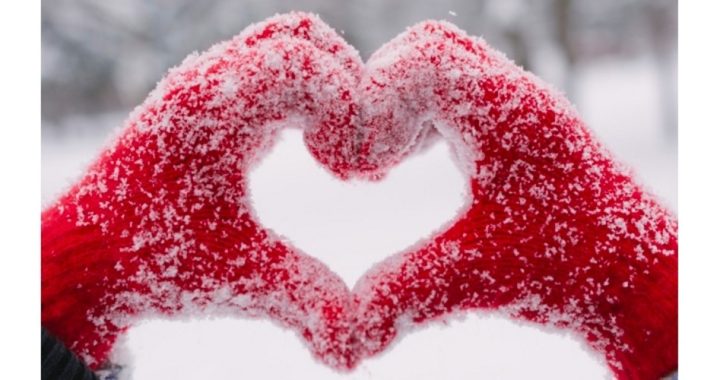
While a Pakistani city was busy banning Valentine’s Day, Mother Nature put her own chill on the holiday closer to home: Low-temperature records were shattered in parts of the Northeast, with one area in New York registering a wind chill of minus 114 degrees Fahrenheit.
The Big Apple felt the freeze, setting a February 14 record of -1° F (actual temperature). But that was downright balmy compared to Watertown, N.Y., 300 miles north, where the mercury dipped down to -37° F. Yet it was Amasa, Michigan, and North Conway, New Hampshire, which had the nationwide low, with a spittle-solidifying -40° F.
And you can blame it all on migration across the border — migration of air across the Canadian border, that is. AccuWeather.com writes that the arctic temperatures were assisted “by a southward shift in the polar vortex,” which “is a storm that is typically centered near the North Pole and tends to keep the coldest air trapped in northern Canada. Occasionally, this storm weakens or shifts enough to allow frigid air to plummet southward into the United States.”
And thus could we have the aforementioned eyebrow-raising -114° wind chill — at Whiteface Mountain near Lake Placid, New York. Placid described much of the Northeast, however, with residents staying indoors and public officials recommending they do so. NYC’s mayor “Bolshevik” Bill de Blasio, not welcoming the redistribution of cold air from the Great White North, emphasized how it wasn’t “business as usual” and that “people should change their habits.” And sometimes they had no choice, as utilities were down in certain areas. Sheffield, Vermont, was an example, where Selectboard Chairman Walter Smith lost a greenhouse full of about 500 orchids after his emergency generator malfunctioned.
But it was a Valentine’s warning about the “Greenhouse Effect” that was most comical. In a February 10 posting entitled “Climate & Chocolate,” “The federal National Oceanic and Atmospheric Administration (NOAA) is officially on record this Valentine’s Day as worrying about the future of Valentine’s Day around the world” (and not because of Muslim prohibitions), reports Climate Depot.
A tweet from NOAA asked, “Is chocolate your favorite Valentine’s Day treat? See how it is affected by climate.” The bureaucracy also tells us at its website, Climate.gov, “Chocolate grows best in the places where it would quickly melt in your hands. Over the next several decades, those places may grow warmer, drier, and less suitable to cacao cultivation. But with planning and adaptation, cacao farmers can keep producing our favorite treat.” Otherwise, your dopamine rush is history.
If it’s just a matter of whose epicurean ox is being gored, however, we might wonder how the government will win over egg lovers. I mean, if the NOAA is right, without “planning and adaptation” we’ll soon enjoy the ease of frying an egg on any sidewalk.
But we shouldn’t hold our breath waiting. Jokes and anecdotes aside, climate realists point out that there has been no warming for more than 18 years. As Climate Depot wrote in January, “The RSS satellite dataset shows no global warming at all for 224 months from May 1997 to December 2015 — more than half the 444-month satellite record.” In point of fact, we may be poised to enter another ice age.
That’s precisely what scientists in the 1970s warned of, mind you. And they insisted on being taken seriously just as today’s alarmists do. I remember hearing these doomsday predictions in grade school (scary for a young child), but don’t take my word for it. As Dr. Walter E. Williams wrote in 2008:
At the first Earth Day celebration, in 1969, environmentalist Nigel Calder warned, “The threat of a new ice age must now stand alongside nuclear war as a likely source of wholesale death and misery for mankind.” C.C. Wallen of the World Meteorological Organization said, “The cooling since 1940 has been large enough and consistent enough that it will not soon be reversed.” In 1968, Professor Paul Ehrlich, Vice President Gore’s hero and mentor, predicted there would be a major food shortage in the U.S. and “in the 1970s … hundreds of millions of people are going to starve to death.” Ehrlich forecasted that 65 million Americans would die of starvation between 1980 and 1989, and by 1999 the U.S. population would have declined to 22.6 million. Ehrlich’s predictions about England were gloomier: “If I were a gambler, I would take even money that England will not exist in the year 2000.”
Of course, England is rumored to still exist, though with its cuisine some wonder how. And what also still exist are climate doomsayers’ pablum predictions. As to this, here are some more climate facts:
• Climate is cyclical. There have been four or five major ice ages and numerous minor ones. In fact, scientists believe we’re currently in an ice age, which began two million years ago and whose pattern is one of 100,000-year glacial periods (cold) followed by warmer 10 to 12,000-year interglacials. There are also 1,500-year cycles of warming and cooling, as well as other phenomena too numerous to mention here.
• During the Cyrogenian period, the Earth was almost completely covered with snow and ice; at other times, frozen precipitation was almost completely absent from the planet.
• Since our current interglacial period has lasted approximately 12,000 years, we’re due for another glaciation. This is far more worrisome than global warming. Most creatures do better in higher temperatures, which is one reason there are infinitely more species in a jungle than an arctic wilderness. The Florida manatee, for instance, cannot survive in water temperatures below 68°F.
• Carbon dioxide isn’t a “pollutant” but a naturally occurring gas necessary for life. It is, in fact, “plant food,” which is why botanists pump it into greenhouses. When CO2 levels are higher, crop yields increase markedly. Thus, the lush foliage characterizing the dinosaur age was no surprise — CO2 levels then were 5 to 10 times today’s.
• Some scientists believe that life on Earth will cease to exist, in approximately a billion years, because CO2 will decrease to a point making photosynthesis impossible.
• Low temperatures and low CO2 would mean starvation for millions of people and animals.
• Oceans rise and fall. At one time the seas around Florida were 100 feet higher, at another 300 feet lower.
• Islands do disappear sometimes. And new ones are created, as happened last year near Tonga in the South Pacific.
• “Scientists say that only one in a thousand species that have ever lived survives today,” writes PBS.org. “The other 99.9 percent are extinct, gone forever” — almost none of them wiped out by man. Moreover, continues PBS, “[T]he life span of individual species is short by geological standards, on average between 2 and 10 million years.”
So be a good shepherd of the Earth, yet know that everything of this world is impermanent. But, hey, at least for now we still have chocolate.



